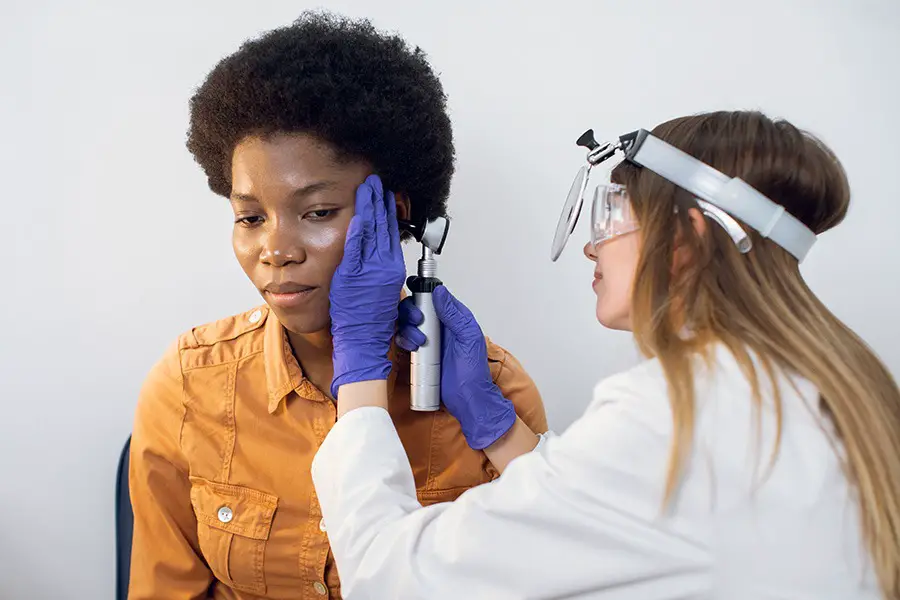Introduction
Hearing plays a pivotal role in a child’s development, acting as a linchpin for language development, communication proficiency, and socio-emotional maturity. Sensorineural hearing loss (SNHL), the predominant form of permanent hearing loss, significantly influences a child’s developmental pathway. This in-depth review intends to probe the complexities of pediatric SNHL, analyzing its effect on child development, the necessity for early detection and intervention, and the challenges and victories that punctuate this story.
Comprehending SNHL in children is an intricate task. It involves a complicated combination of genetics, environmental influences, medical treatments, educational systems, and the child’s resilience. It is a journey laden with obstacles but also filled with triumphs and inspiring stories of children overcoming barriers. This detailed review will critically assess each facet of pediatric SNHL, enhancing our comprehension and fostering a broader viewpoint.
Throughout this review, it is critical to remember that while this examination may appear critical, it does not negate the remarkable progress achieved in this field. Instead, the purpose is to highlight areas for improvement, spark discussions, and contribute to the advancement of strategies and solutions in pediatric SNHL.
The Impact of Sensorineural Hearing Loss on Child Development
The initial years of a child’s life are a significant phase of swift development and learning. With sensorineural hearing loss, children encounter barriers in key developmental areas. This interruption primarily emerges in delayed language acquisition and speech development due to restricted access to auditory linguistic information. This delay can further influence cognitive functions, literacy skills, and academic achievement.
Furthermore, it can also impact the socio-emotional growth of the child. Children with SNHL might feel isolated and struggle with social interactions due to communication obstacles. These problems emphasize the profound and extensive effect of SNHL on child development, underlining the need for early identification and comprehensive interventions. Early Detection and Intervention in Pediatric Sensorineural Hearing Loss Prompt detection of sensorineural hearing loss is critical in reducing its influence on child development. Newborn hearing screening programs enable the identification of many SNHL cases within the first few days or weeks of a child’s life. Timely detection enables early intervention, which can significantly improve the child’s language, cognitive, and socio-emotional outcomes.
However, despite the necessity for early detection, not all children have access to newborn hearing screening programs, especially in low-resource environments. Furthermore, even when SNHL is detected early, there can be delays in initiating suitable interventions due to system-wide issues and resource limitations. These gaps in detection and intervention services represent significant areas for improvement in combating pediatric SNHL.
Understanding Congenital Sensorineural Hearing Loss
Congenital sensorineural hearing loss, present at birth, can result from genetic factors or prenatal exposure to infections or specific medications. The complex nature of these causes necessitates a deeper understanding and additional research. Despite advancements in genetic testing, the cause of congenital SNHL remains unknown in a substantial number of cases.
A comprehensive comprehension of the etiology of congenital SNHL can guide prevention strategies, inform prognosis, and assist in developing targeted interventions. However, the path towards this understanding is riddled with scientific and ethical challenges, particularly in the field of genetic testing and gene therapy.
Audien BTE (Behind the Ear) Rechargeable OTC Hearing Aid
Experience Unparalleled Sound Quality with the New Audien BTE (Behind the Ear) hearing amplifier. Elevate your hearing with the clearest, highest-quality sound available in an over-the-counter hearing assistance device. Designed by Audien, renowned for their sleek and comfortable hearing devices, the BTE model ensures exceptional hearing performance. It features advanced digital technology, including four environmental modes, background noise reduction, feedback cancellation, and two directional microphones per unit (four in total).
Say Goodbye to Missed Conversations and Hello to Superior Sound. Audien hearing devices excel at amplifying speech while reducing background noise, allowing you to effortlessly engage in conversations with friends and family. Experience the consistent, long-lasting, and sharp sound quality without any whistling or feedback issues. With customizable volume control, you can easily adjust the amplification to meet your individual needs. These devices are perfect for enhancing high tones and improving TV dialogue clarity.
Rechargeable for Uninterrupted Use. The Audien BTE hearing amplifiers are 100% rechargeable, offering convenience and freedom from the hassle of tiny button batteries. With wireless magnetic charging technology, you can enjoy a 20-hour battery life with just a quick two-hour charging time. The included charging case provides up to three full charges, giving you a total of 60 hours of amplified sound. Simply place the devices in the case, and they will wirelessly charge, ensuring you’re always ready to hear your best. Experience the ease and reliability of Audien sound amplifiers, ideal for individuals with dexterity issues or those tired of constantly purchasing and replacing batteries.
Pediatric Sensorineural Hearing Loss: Challenges and Solutions in School
School-age children with sensorineural hearing loss encounter distinct challenges in educational environments. These range from difficulties in auditory learning, communication with peers, to a lack of understanding and accommodation from the educational institutions. It’s crucial to note that these issues can further exacerbate the academic and social disparities experienced by children with SNHL.
Implementing solutions in school settings requires multi-faceted strategies, from using assistive listening devices and classroom accommodations to specialized educational programs and services. Teacher training and nurturing a supportive and inclusive learning environment are just as vital. Despite the availability of these solutions, their application is inconsistent, showing considerable variation across schools and regions. Success Stories: Children Overcoming Sensorineural Hearing Loss Despite the challenges linked to sensorineural hearing loss, numerous children exhibit remarkable resilience and determination. Numerous anecdotes exist of children with SNHL who, with the assistance of early interventions, assistive technology, and educational adaptations, excel academically, thrive socially, and achieve commendable success. Such stories shine a light on the potential that can be unlocked when barriers are eliminated, and the right support systems are implemented.
These success stories, while inspiring, should not be perceived as exceptions but as achievable results. They underline the importance of comprehensive support systems and the transformative power of resilience, further bolstering the argument for widespread and equitable access to interventions and resources for children with SNHL.
Analyzing Pediatric Sensorineural Hearing Loss
The ability to hear is pivotal in a child’s development, influencing language acquisition, communication skills, and socio-emotional growth. The most common type of permanent hearing loss, Sensorineural hearing loss (SNHL), can significantly impact a child’s developmental pathway. A detailed investigation into the intricacies of pediatric SNHL can shed light on its effect on child development, the necessity of early detection and intervention, and the obstacles and victories that mark this journey.
The understanding of SNHL in children is far from simple. It involves a complicated blend of genetics, environmental influences, medical interventions, educational systems, and the child’s resilience. This journey, while marked by challenges, is also filled with victories and inspiring accounts of children surpassing difficulties. This detailed exploration will critically assess each facet of pediatric SNHL, broadening our comprehension and fostering a more holistic perspective.
While this investigation may present a critique, it by no means negates the incredible progress accomplished in this field. The aim is to pinpoint areas for improvement, stimulate discussions, and contribute to the evolution of strategies and solutions for pediatric SNHL.
The Influence of Sensorineural Hearing Loss on Child Development
During a child’s early years, rapid development and learning take place. For children with sensorineural hearing loss, hurdles arise in key developmental areas. This disruption primarily presents as delayed language acquisition and speech development due to restricted access to auditory linguistic stimuli. This delay can subsequently influence cognitive abilities, literacy skills, and academic achievements.
Furthermore, it can impact the child’s socio-emotional development. Children with SNHL may experience feelings of seclusion and struggle to socialize with peers because of communication obstacles. These issues underscore the significant and far-reaching effect of SNHL on child development, emphasizing the necessity for early identification and comprehensive interventions.
Early Detection and Intervention in Pediatric Sensorineural Hearing Loss
Detecting sensorineural hearing loss early on is crucial in minimizing its impact on child development. Newborn hearing screening programs can identify many cases of SNHL within the first few days or weeks of a child’s life. Timely detection enables early intervention, which can considerably improve the child’s language, cognitive, and socio-emotional outcomes.
However, despite the importance of early detection, not all children have access to newborn hearing screening programs, particularly in settings with limited resources. Additionally, even when SNHL is identified early, initiating suitable interventions may be delayed due to systemic issues and resource limitations. These gaps in detection and intervention services represent critical areas requiring improvement in managing pediatric SNHL.
Understanding Congenital Sensorineural Hearing Loss
Congenital sensorineural hearing loss, present from birth, can be a result of genetic factors or prenatal exposure to infections or specific medications. The intricate nature of these causes warrants a deeper understanding and additional research. Despite advancements in genetic testing, the cause of congenital SNHL remains unidentified in a significant number of cases.
A comprehensive understanding of the etiology of congenital SNHL can guide preventive strategies, inform prognosis, and aid in the development of targeted interventions. However, the path towards this understanding is marked by scientific and ethical challenges, particularly in the field of genetic testing and gene therapy.
QUIZ - AVAILABLE TREATMENTS FOR TINNITUS
Pediatric Sensorineural Hearing Loss: Challenges and Solutions in School
School-age children with sensorineural hearing loss face unique hurdles in educational settings. These range from difficulties in auditory learning, communication with peers, to a lack of understanding and accommodation by educational institutions. These issues can further compound the academic and social disparities faced by children with SNHL.
Implementing solutions in school settings involves multi-faceted strategies, from the use of assistive listening devices and classroom accommodations to specialized educational programs and services. Equally important are teacher training and the creation of a supportive and inclusive learning environment. Despite the existenceof these solutions, their application is inconsistent, with substantial variation across schools and regions.
Triumphs: Children Overcoming Sensorineural Hearing Loss
Despite the challenges presented by sensorineural hearing loss, numerous children exhibit remarkable resilience and determination. There are plentiful stories of children with SNHL who, with the support of early interventions, assistive technology, and educational accommodations, excel academically, flourish socially, and achieve notable success. Such narratives illuminate the opportunities that are possible when barriers are eliminated and appropriate support is provided.
These triumphs, while inspiring, should not be viewed as exceptions but as achievable outcomes. They underscore the importance of comprehensive support systems and the transformative power of resilience, reinforcing the argument for widespread, equitable access to interventions and resources for children with SNHL.
Conclusion
Examining pediatric sensorineural hearing loss from an academic perspective allows for a more profound understanding of the intricate interplay between the condition, the child, and their environment. The discussion above articulates the extensive effect of SNHL on a child’s development and the critical importance of early detection and intervention. It also brings attention to the systemic and logistical challenges faced when implementing school-based solutions and the resilient spirit of children navigating these challenges.
However, there are significant gaps, particularly regarding the understanding and management of congenital sensorineural hearing loss. While advances in genetics provide some insight, the etiological conundrum of a significant number of cases persists. This conundrum, coupled with the ethical dilemmas surrounding genetic interventions, provides plenty of scope for future research and policy debates.
It’s also vital to acknowledge the substantial variation in the experiences and outcomes of children with SNHL, serving as a reminder of the role of individual resilience and systemic support. The inspiring stories of children overcoming sensorineural hearing loss should serve as potent motivators for extending access to early interventions, assistive technology, and supportive educational environments.
In conclusion, pediatric sensorineural hearing loss continues to be a complex, multi-dimensional challenge that requires a comprehensive, collaborative approach to tackle effectively. From researchers and healthcare professionals to educators and policymakers, each stakeholder plays a crucial role in shaping the narrative of pediatric SNHL. As this discussion demonstrates, there is a compelling need to enhance our understanding, improve interventions, and foster environments that empower children with SNHL to reach their maximum potential.
Lastly, it’s important to recognize that while the analytical approach used here has highlighted gaps and areas of improvement, it also acknowledges the significant progress made so far. There is reason for hope, but it’s a cautious optimism, tempered by the knowledge of the work still required.

Decoding Silence: An Analytical View on the Advances in Conductive Hearing Loss Research and Treatment
This analytical article sheds light on conductive hearing loss, offering an in-depth exploration of its genetic factors, treatment advances, and promising experimental therapies.

Embracing the Melody of Life: Navigating the Journey with Conductive Hearing Loss
A blog post delving into the experiences and challenges of living with conductive hearing loss, discussing its impact on everyday life, social interactions, mental health, and the potential benefits of hearing aids and cochlear implants.





